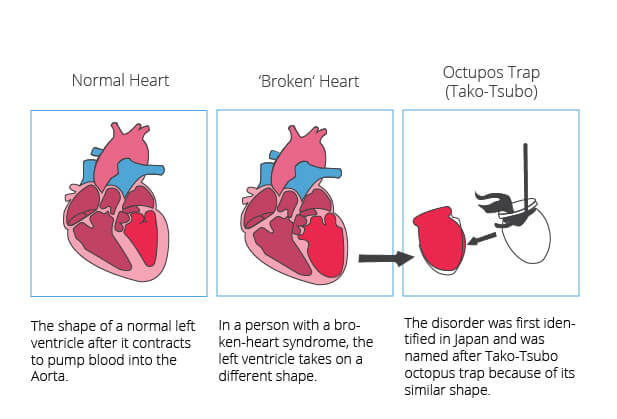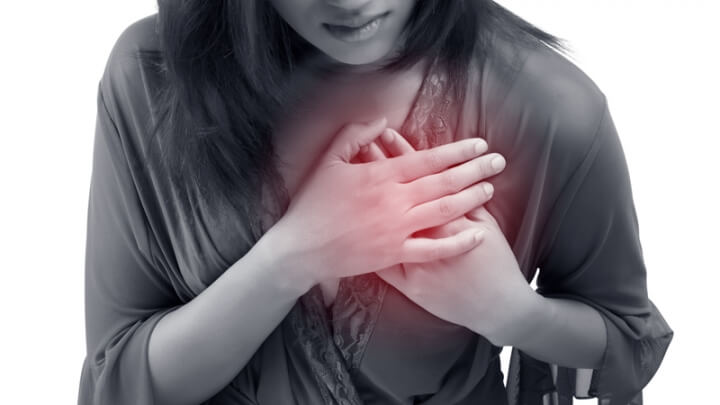
Broken Heart Syndrome: Tips On How To Detect This Fatal Heart Disease That’s Affecting Women
Lifestyle Mar 16, 2022
Stress-induced cardiomyopathy also known as “The Broken Heart Syndrome” is a heart condition that has been affecting women at increasing rates. We take a closer look at what exactly this is, what causes it, and tips on how to detect this fatal heart disease before it’s too late.
In the words of Alicia Keys, have you ever tried sleeping with a broken heart?
Well, for many women, you may unknowingly be doing exactly that, and it can be detrimental to your health.
Throughout the pandemic, the prevalence of “Broken Heart Syndrome” has risen “…from less than 2% to almost 8%,” reports InStyle.
I know what you’re thinking: did she just say “broken heart syndrome?!” Surely, that’s not a real thing.
Unfortunately, while the name takes away from the seriousness of this type of diagnosis, “Broken Heart Syndrome” is quite real and impacts women far more frequently than men. For South Asian women, this is even more concerning as the American College of Cardiology highlights that while the South Asian community only makes up about “…25 percent of the world’s population …they account for 60 percent of the world’s heart disease patients.”
Here’s The Rundown On “Broken Heart Syndrome” From Dr. Sherryn Rambihar (MD, MHPE, FRCPC, FASE)
I’m hardly qualified to talk about these particular matters of the heart, and so I sat down with Dr. Sherryn Rambihar (MD, MHPE, FRCPC, FASE) who gave me all of the important details about “Broken Heart Syndrome.”
Dr. Rambihar has an impressive resume and is currently a staff cardiologist at Mackenzie Health, and she is an Adjunct Assistant Professor in the Division of Cardiology, Department of Medicine at the University of Toronto. She’s also involved in community health promotion, especially in vulnerable communities in the Greater Toronto Area (Canada) and is a spokesperson for the Heart and Stroke Foundation’s Women’s Heart Health campaign.

“Broken Heart Syndrome” was discovered in 1991 by Japanese scientists, explains News Medical, and is commonly referred to as Takotsubo cardiomyopathy or stress cardiomyopathy. Originally, notes InStyle, the word “takotsubo” was used as “…the shape of the left ventricle on an angiogram looks like the same-named ceramic pot used to capture octopuses in the ocean.”
However, as connections between emotional stress and Takotsubo cardiomyopathy were established, the illness was dubbed “Broken Heart Syndrome.”

Should South Asian Women Be More Concerned About “Broken Heart Syndrome?”
Dr. Rambihar explains that ““broken heart syndrome” is equally concerning to all women. However, as these symptoms could represent typical heart disease, South Asian women need to be aware that they are at increased risk of heart disease. [In addition,] pregnancy-related complications (hypertensive disease of pregnancy, gestational diabetes, pre-term birth, stillbirth, low birth weight infants, placental abruption) are now considered risk factors for [the] development of early heart disease in all women and screening these women periodically to prevent heart disease is now recommended.”
That said, Dr. Rambihar shared that “updated Canadian and American Guidelines recommend screening of all South Asian individuals at an earlier age than the general public, as there is a greater opportunity to prevent [the] development of life-threatening disease. The increased risk of heart disease [stems] from several factors including a genetic predisposition to [the] body shape with abdominal obesity (an “apple shape”) and tendency to develop diabetes and metabolic syndrome at lower waist circumference than other ethnic populations.”
Before you start to rapidly exercise your Google MD certifications, Dr. Rambihar graciously explained what the difference is between a run-of-the-mill heart attack and “Broken Heart Syndrome: ““Broken Heart Syndrome” shares many features with acute heart attacks. [However,] unlike a typical heart attack, which is precipitated by a ruptured fatty cholesterol plaque in a heart artery, “Broken Heart Syndrome” is associated with preceding physical and/or emotional (both positive and negative) triggers.”
The good news, Dr. Rambihar shared, is that the temporary “heart abnormalities [experienced by patients] generally resolve over 4-8 weeks [and] the majority of cases are benign.” Nonetheless, this positive news does come with a bit of a reality check, as “large international registries of recovered patients demonstrate that some patients with “broken heart syndrome” have reduced life expectancy compared to the general population, with risk of future recurrence.”

Am I At Risk?!
Dr. Rambihar explained that “based on a contemporary international cohort, 90% of patients with “Broken Heart Syndrome” are women with a mean age of 67–70 years, and around 80% are older than 50 years.”
In fact, Dr. Rambihar notes that post-menopausal women are typically impacted by this condition, which “suggests a connection between declining estrogen levels, with subsequent downregulation of vasomotor tone, increased sensitivity to adrenaline vasoconstriction, and increased sympathetic nervous system response to mental stress, although research has not yet found a clear link.”

Some other possible factors, according to Dr. Rambihar, for the occurrence of “Broken Heart Syndrome” in women, include the following:
- The brain-heart axis: women are more affected by anxiety and depression, and there is a high prevalence of these conditions in patients with Broken Heart Syndrome. There may also be differences in how the limbic system, which processes emotional cues and cognition, interacts with circulating stress hormones.
- Epicardial spasm: typically presents as sudden chest pain
- Endothelial dysfunction: according to Stanford Health Care, this “…is a type of non-obstructive coronary artery disease (CAD) in which there are no heart artery blockages, but the large blood vessels on the heart’s surface constrict (narrow) instead of dilating (opening).” Patients often experience ongoing chest pain.
- Microcirculatory dysfunction: Standford Health Care explains that this “…type of non-obstructive coronary artery disease that causes the small blood vessels feeding the heart muscle to not work as they should.”
Signs And Symptoms:
Dr. Rambihar outlined the common “Broken Heart Syndrome” symptoms to watch out for below:
- Acute chest pain
- Shortness of breath
- Fainting
However, some less common symptoms include the following:
- Epigastric discomfort: according to Healthline, this is “…pain or discomfort right below your ribs in the area of your upper abdomen.”
- Dizziness
- Heart palpitations
It is crucial to pay attention to listen to your heart (literally) and what your body is telling you. This is especially important for women, who are “often underdiagnosed when they present with symptoms of heart disease and under-referred for expedited treatment and testing, [which]… may have serious consequences” explains Dr. Rambihar.
Prevention Is KEY
According to Dr. Rambihar, it’s hard to determine if you will or won’t develop “Broken Heart Syndrome” or other cardiovascular diseases. As such, she explains that “a heart-healthy lifestyle is key to preventing both heart attack and “broken heart syndrome,” including smoking cessation, alcohol moderation, maintaining a healthy weight, consuming a balanced diet, striving for 30 minutes of moderately vigorous cardiovascular activity five days a week, and paying attention to stress reduction and adequate sleep.”
In addition, Dr. Rambihar stresses that “controlling reversible cardiac risk factors including diabetes, hypertension, dyslipidemia and sleep apnea are important. If you have a genetic predisposition including [a] family history of premature coronary disease or significant hypercholesterolemia, peri/post-menopausal status, inflammatory arthritis and rheumatologic conditions, and pregnancy-related complications, even if asymptomatic, discuss screening and surveillance with your primary care practitioner.”

If you’re interested in learning more about heart health, check out these fabulous resources:
- Heart and stroke: healthy stress
- Toronto Rehab/UHN (translations are available in Hindi, Punjabi, Arabic)
- UHN (female-focused)
Lastly, if there’s one thing Dr. Rambihar could not emphasize enough, it’s this: “it is extremely important for women to be aware that heart events can happen from different triggers, including emotional stress, to self-acknowledge symptoms, to seek urgent medical attention when they do not feel well, and to advocate for themselves and ensure their symptoms are taken seriously.”
Main Image Photo Credit: www.therelationshipresource.ca
Devika Goberdhan | Features Editor - Fashion
Author
Devika (@goberdhan.devika) is an MA graduate who specialized in Political Science at York University. Her passion and research throughout her graduate studies pushed her to learn about and unpack hot button issues. Thus, since starting at ANOKHI in 2016, she has written extensively about many challe...













































































































